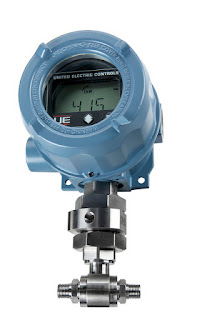 |
An accurate pressure transmitter
is an integral part of a liquid level
measurement system using the
"Bubbler Method"
Courtesy Brooks Instrument |
Measuring liquid level in a tank or vessel can be accomplished in a number of ways, all of which require some arrangement of instrumentation to either infer the liquid level from the measurement of a related physical property, or directly deliver the liquid level visually using a scaled gauge arrangement. One indirect method of level measurement is often referred to as the bubbler method, so named because it employs a purging gas that continually vents from the bottom of a tube extending into a tank of liquid. Through a simple apparatus, the level of a liquid can be inferred by the amount a back pressure exerted upon the gas flowing through the tube.
Probably the greatest advantage of this method of liquid level measurement is that the liquid does not contact the sensing instrumentation. The only portion of the apparatus in contact with the liquid is a tube immersed into the tank. Basically, a purge gas flows through the immersion tube and may bubble out the immersed end of the tube, which is open to allow the contained liquid to exert a hydrostatic pressure on the purge gas. The back pressure on the gas that is exerted by the liquid contained within the tank will vary directly with the depth of the liquid. The back pressure can be correlated to a liquid level. Further calculations, which would include the tank shape, dimensions, and the liquid density can provide an indication of the volume and mass of the liquid. Here is an illustration of the setup, provided courtesy of
Brooks Instrument, globally recognized leader in flow and pressure measurement and control. The illustration is from
Brooks' January blog article.
 |
| Bubbler Method Tank Level Measurement Apparatus, showing application of some Brooks Instrument devices. |
Below are data sheets detailing the components used in the system to control and measure the gas flow, and measure the back pressure on the immersion tube. There are other components needed for a complete system, but they are fairly generic in nature and easily obtainable. Contact a flow and level measurement
specialist with your application challenges and work with them to produce effective solutions.









